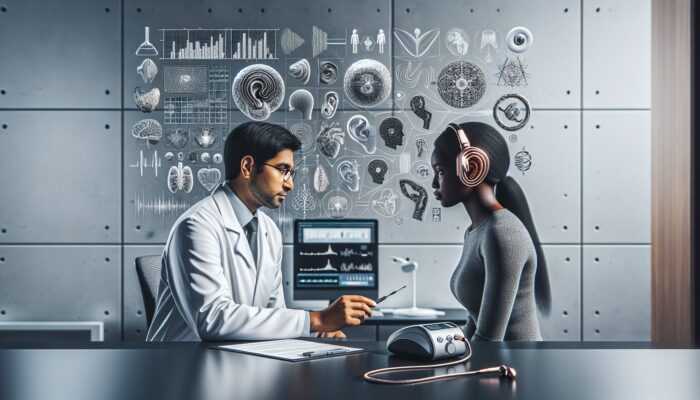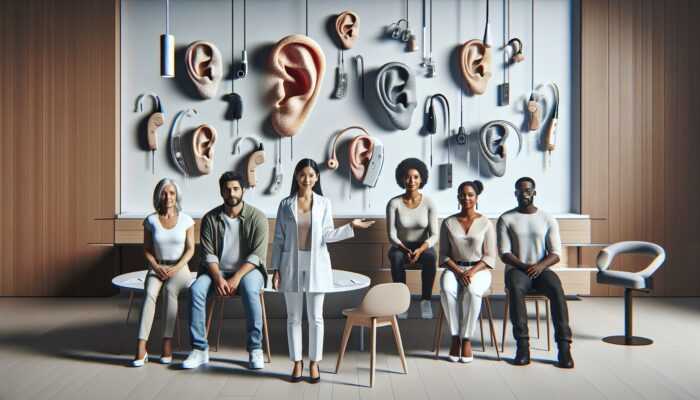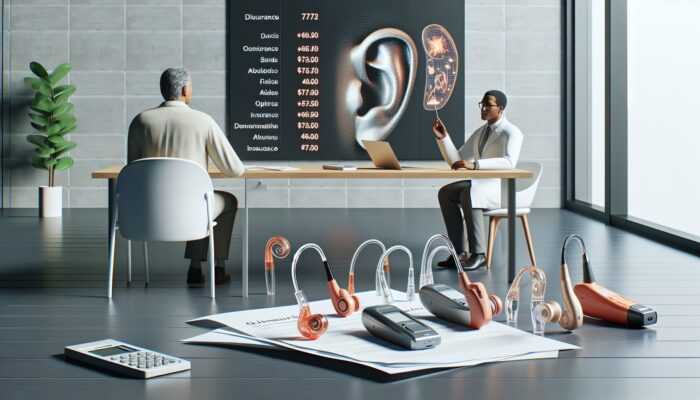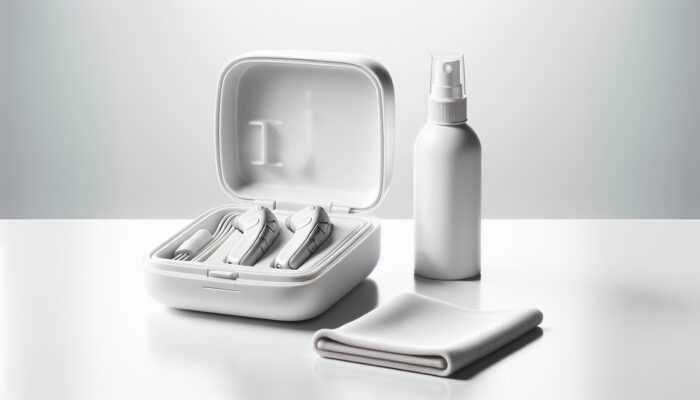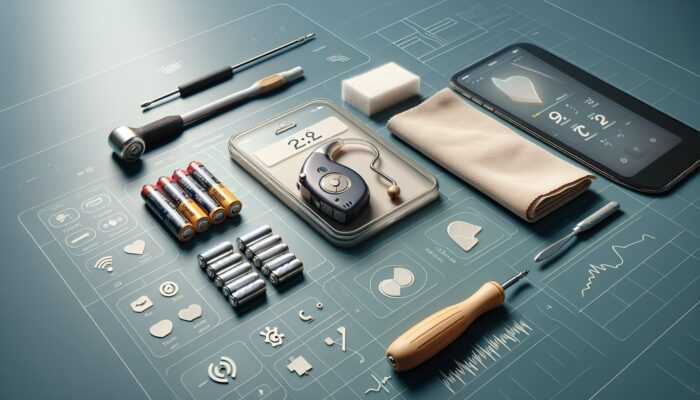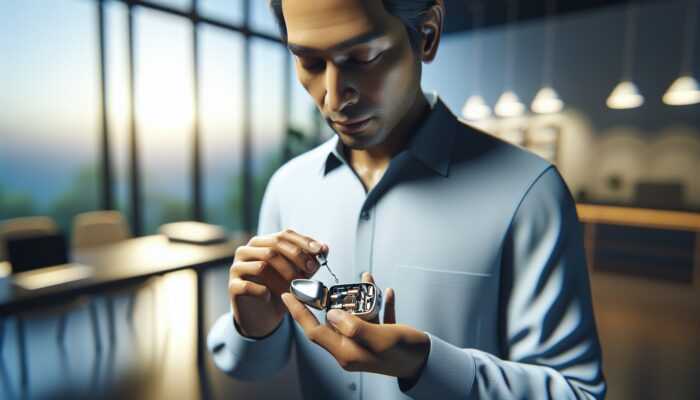The Crucial Role of Personalisation in Hearing Aid Effectiveness
Customising Hearing Solutions to Address Unique Hearing Loss Profiles

Understanding the distinct patterns of individual hearing loss is vital for maximising the effectiveness of hearing aids. The anatomy of the human ear is complex, with various elements—such as age, exposure to loud noises, and genetic factors—contributing to hearing loss. An extensive professional fitting process allows audiologists to accurately identify specific frequencies where an individual may experience challenges. For example, for someone dealing with high-frequency hearing loss, targeted enhancements can greatly improve their auditory experience, facilitating a richer enjoyment of conversations, music, and everyday sounds.
Personalisation goes beyond simple adjustments; it encompasses a thorough examination of the individual’s hearing profile to ensure that the hearing aids are optimally configured for exceptional sound clarity. This detailed approach can significantly enhance the overall auditory experience, improving the user’s ability to engage in daily activities. For instance, an individual who regularly attends live performances would benefit immensely from settings designed to amplify detail and clarity in music, while someone who often finds themselves in quiet environments may need different settings to optimise their auditory experience.
The outcome of such tailored tuning extends beyond merely improved hearing; it results in a profoundly immersive audio experience, where users feel increasingly connected to their surroundings. This transformation enhances their interactions with friends, family, and the wider community, allowing them to fully engage rather than feel isolated due to hearing difficulties.
Enhancing Comfort for Hearing Aid Users
Comfort is paramount in the success of hearing aids, as discomfort can lead to users abandoning their devices entirely. Professional tuning addresses common concerns, such as bothersome feedback sounds—those irritating whistling noises—and ensures that hearing aids fit snugly within the ear canal. When hearing aids are finely tuned, they provide a more enjoyable listening experience, reducing the chances of irritation or discomfort during use.
A well-fitted hearing aid can feel like an integral part of the body. Professionals employ various techniques to ensure that the device is not only physically comfortable but also acoustically pleasant. By meticulously adjusting sound levels and feedback responses, audiologists can create an experience in which users can comfortably wear their hearing aids for extended periods, leading to greater overall satisfaction.
Furthermore, specialised fittings are available to accommodate diverse lifestyles. For example, an active individual may require a more secure fitting to prevent slippage during physical activities. In contrast, a user who spends most of their time in quieter settings may prioritise sound clarity without the distraction of background noise, requiring a different tuning approach.
Customising Hearing Aids to Suit Lifestyle Preferences
Hearing aids must be flexible and adaptable to various lifestyle requirements and environments to effectively fulfil their purpose. Professionals assess each user’s daily routines and modify device settings accordingly. For individuals who frequently transition between bustling public spaces and tranquil home settings, the need for dynamic adjustments becomes evident.
Consider a user who regularly engages in a mix of activities, from attending crowded events to relishing peaceful afternoons at home. Each setting introduces unique auditory challenges that necessitate specific configurations. Professional tuning can establish tailored presets for distinct scenarios, allowing users to switch seamlessly between them. For example, in a noisy restaurant, directional microphones can be optimised to focus on conversations, effectively filtering out overwhelming background noise, while adjustments in a calm environment can enhance subtle sounds.
Moreover, advancements in technology now allow for programmable hearing aids that can learn user preferences over time. By incorporating these features, audiologists provide users with a more personalised experience that evolves in tandem with their needs. This adaptability instils a sense of control, enabling individuals to enjoy their daily lives without the constant frustration of manually adjusting their hearing aids.
Incorporating Innovative Technology into Hearing Aids

Utilising Advanced Features for Enhanced Hearing Performance
In the rapidly developing field of hearing technology, employing the latest features is essential for an improved user experience. Professional tuning ensures that users can fully leverage state-of-the-art technologies, such as noise reduction, which effectively filters out distracting sounds, and directional microphones that focus on sounds from a particular direction. This not only enriches the auditory experience but also enhances engagement in conversations, especially in challenging auditory environments.
For example, in a lively social setting, such as a bustling café, sophisticated hearing aids can adeptly distinguish between background chatter and the voice of a friend seated at the same table. Such capabilities can significantly improve social interactions, allowing users to feel more confident and included in group settings. Professionals can optimise these features through precise tuning, ensuring they align with the user’s unique hearing profile while considering individual auditory preferences.
Additionally, the integration of smartphone compatibility has revolutionised how users interact with their hearing aids. Many modern devices can connect via Bluetooth, facilitating seamless streaming of music or phone calls directly into the hearing aids. Professional tuning guarantees that these connections are optimised for sound quality, making it easier for users to enjoy their favourite media without the interference of background noise or distortion.
Enhancing Digital Signal Processing for Superior Sound Quality
Digital Signal Processing (DSP) is fundamental to contemporary hearing aids, converting sound waves into clear and intelligible audio. Professional tuning is crucial for optimising DSP to align with individual hearing needs. This process involves fine-tuning the algorithms that govern sound amplification and processing, specifically targeting frequencies where users experience hearing loss.
By analysing individual hearing profiles, audiologists can adjust the gain, compression, and equalisation settings to ensure that every sound is delivered at an appropriate level. For instance, individuals with significant hearing loss in lower frequencies may require specific tuning to enhance those sounds while preventing excessive amplification in frequencies that they can hear adequately.
Furthermore, optimising DSP contributes to natural sound quality, diminishing the perception of distortion that can occur when devices are improperly set. Users can savour the subtleties of their surroundings, from the gentle rustle of leaves to the intricate nuances of a musical performance, resulting in a more enriching auditory experience. This technical precision in tuning not only enhances sound quality but also fosters greater satisfaction and confidence in using hearing aids.
Ensuring Seamless Compatibility with Other Technology

As technology continues to advance, ensuring compatibility with a range of devices is essential for modern hearing aids. Professionals are tasked with tuning devices not only for standalone performance but also for seamless integration with smartphones, televisions, and various assistive technologies. This compatibility is crucial in today’s interconnected world, where users expect smooth experiences across devices.
For example, many hearing aids now offer direct streaming capabilities, allowing users to receive audio straight from smartphones or tablets. Professional tuning aids in calibrating these connections, ensuring that sound quality is optimised, regardless of the source. Whether it’s enjoying music, participating in video calls, or watching television, the clarity and richness of sound are heavily influenced by how well the hearing aids are tuned for these activities.
Moreover, compatibility extends to assistive listening devices commonly employed in public venues, such as theatres and auditoriums. Professionals can fine-tune hearing aids to work effectively with these systems, enhancing the listening experience across various settings. By ensuring that users can effortlessly connect to different technologies, professionals enhance convenience and accessibility, simplifying navigation through their auditory world.
Commitment to Ongoing Maintenance and Updates
The Importance of Regular Check-ups for Hearing Aids
Regular maintenance is essential for the longevity and performance of hearing aids. Scheduled check-ups with audiologists ensure that devices remain in peak condition, delivering the best possible sound quality. During these appointments, professionals can assess the performance of the hearing aids, checking for any signs of wear and tear that could impact functionality.
Routine check-ups offer an opportunity for users to discuss any changes in their hearing or experiences with the devices. Audiologists can evaluate the need for adjustments based on user feedback, ensuring that the hearing aids continue to meet evolving needs. For example, as a user’s hearing may fluctuate over time, recalibrating the devices can significantly enhance their auditory experience.
Additionally, these appointments allow for thorough cleaning and maintenance, which are crucial for preventing issues caused by dirt or moisture accumulation. Professionals can perform necessary repairs or replace components as needed, extending the lifespan of the hearing aids. Regular check-ups, therefore, play a significant role in maintaining optimal performance, ultimately leading to increased user satisfaction and engagement.
The Significance of Software Updates for Optimal Performance
Similar to smartphones and computers, hearing aids require regular software updates to maintain peak performance. These updates often include new features, enhancements in sound processing, and improvements in compatibility with other devices. Professionals are instrumental in ensuring that users receive the latest advancements, significantly enhancing their overall experience.
During routine check-ups, audiologists can update the software of the hearing aids, allowing users to benefit from the latest technology. This is particularly important as hearing aid manufacturers continually refine their products, responding to customer feedback and technological advancements. Users can enjoy features such as advanced noise cancellation or improved sound quality simply by keeping their devices up to date.
Moreover, these updates frequently include security enhancements, ensuring that users’ information and device functionalities remain protected. This aspect of maintenance is critical in an era where data privacy is increasingly concerning. By prioritising software updates, professionals help users maximise their hearing experience while feeling confident in the security and reliability of their hearing aids.
Proper Maintenance: Cleaning and Repairs
Maintaining the cleanliness of hearing aids is crucial for preserving performance and preventing damage. Professional maintenance encompasses comprehensive cleaning that addresses common issues like wax buildup, exposure to moisture, and general wear and tear. Such factors can significantly impact sound quality and the overall effectiveness of the devices.
Audiologists possess the knowledge and tools necessary to clean hearing aids thoroughly. They can identify areas needing specific attention, ensuring that all components function optimally. Regular professional cleaning prolongs the lifespan of the devices, reducing the need for costly repairs or replacements in the future.
In addition to cleaning, professionals offer vital repair services. Whether it involves a minor adjustment or a significant fix, having access to expert repairs ensures users can rely on their hearing aids without interruptions. This comprehensive approach to maintenance provides users with peace of mind, knowing their devices are in capable hands, allowing them to remain fully engaged with the world around them.
Managing Battery Performance for Hearing Aids
Battery life is a critical aspect for hearing aid users. Regular maintenance includes checking and replacing batteries as necessary to ensure optimal performance. Professionals can assess battery health and provide recommendations on best practices for prolonging battery life, such as avoiding extreme temperatures and ensuring proper storage conditions.
Understanding when to replace batteries is crucial, as weak batteries can lead to diminished sound quality and overall performance. Audiologists can assist users in identifying signs that batteries may need replacement, preventing interruptions in their hearing experience. Furthermore, they can introduce users to advanced battery technologies, such as rechargeable options, which offer convenience and sustainability.
Moreover, proper training on battery care and usage can empower users to take control of their hearing aids. Professionals can explain how to maximise battery efficiency and troubleshoot common issues. This comprehensive approach to battery maintenance ensures that users enjoy a consistently reliable auditory experience without the worry of sudden battery failures.
The Importance of Firmware Upgrades for Optimal Functioning
Firmware upgrades are essential for keeping hearing aids functioning at their highest level. Over time, manufacturers may release updates to enhance device performance, introduce new features, or rectify issues. Professional tuning involves ensuring that hearing aids have the latest firmware installed, enabling users to benefit from ongoing technological advancements.
These upgrades are typically designed to improve sound processing algorithms, enhance connectivity features, and provide a better overall user experience. By staying current with firmware, users can enjoy the latest benefits without the need to frequently purchase new devices. This not only saves costs but also boosts user satisfaction by maintaining the cutting-edge capabilities of their existing equipment.
Professionals play a pivotal role in managing firmware upgrades, conducting them during routine check-ups or as needed based on user experiences. This proactive approach ensures that hearing aids operate at peak efficiency, enabling users to remain connected to their environment without the frustrations of outdated technology.
Responding to User Feedback for a Superior Experience
Addressing Sound Issues with Precision
User feedback is indispensable in the professional tuning process, particularly when it comes to resolving sound issues. Many users may encounter problems such as feedback, distortion, or imbalanced sound. Professionals can fine-tune hearing aids to directly address these concerns, ensuring a smoother and more enjoyable auditory experience.
For example, if a user frequently reports feedback noise, audiologists can adjust the gain settings and explore different fitting options. Engaging actively with users about their experiences allows professionals to make precise adjustments that significantly affect satisfaction and usability. This responsiveness is crucial in fostering trust and confidence in hearing aid technology.
Moreover, professionals can utilise advanced diagnostic tools to evaluate sound quality and pinpoint issues that users may not be aware of. By leveraging technology alongside user feedback, audiologists can fine-tune settings and create a sound profile that aligns with individual preferences and needs, ultimately enhancing the quality of life.
Enhancing the Overall User Experience
Improving the user experience is a vital focus for professionals working with hearing aids. Regular adjustments based on user feedback can lead to substantial enhancements in comfort, functionality, and overall satisfaction. Audiologists often conduct follow-up visits to discuss any concerns or changes in hearing, tailoring the tuning process to meet evolving needs.
A key aspect of this process involves understanding the user’s lifestyle and the specific challenges faced in different environments. For instance, if a user struggles in social situations but finds listening in quiet spaces manageable, professionals can refine settings to prioritise clarity in noisy contexts. This personalised approach fosters a better user experience, empowering individuals to engage more fully in their daily lives.
Furthermore, ongoing communication between the user and the audiologist is essential. Establishing a feedback loop encourages users to share their experiences, promoting continuous improvement in device performance. This collaborative relationship can significantly enhance user satisfaction, as adjustments are made in real-time based on real-world encounters.
Customising Hearing Aids to Individual Preferences
Every user has unique hearing preferences and requirements that must be considered during the professional tuning process. Audiologists are trained to customise hearing aids to meet these specific needs, enhancing individuality in their sound profiles. Whether it involves adjusting frequency responses for optimal speech clarity or optimising settings for music enjoyment, tailored tuning creates a more satisfying auditory experience.
For instance, someone passionate about classical music may require specific enhancements in mid-range frequencies to appreciate the subtleties of orchestral compositions. Conversely, an individual who values social interactions may benefit from features that prioritise speech intelligibility in crowded environments. This degree of customisation not only improves listening experiences but also fosters deeper connections to the world around them.
Additionally, professionals may implement varying levels of customisation based on user feedback over time. As individuals acclimatise to their hearing aids, their needs may evolve, necessitating further adjustments. This fluid approach to customisation ensures that users remain satisfied with their devices, enhancing engagement and participation in daily activities.
Implementing Effective Feedback Mechanisms
Establishing effective feedback mechanisms is crucial for continuously enhancing the hearing aid experience. Professionals encourage users to share their experiences with the devices, gathering insights on performance and comfort. This open dialogue is vital for identifying areas that need attention and improvement, allowing audiologists to make timely adjustments.
By regularly soliciting feedback, audiologists can deepen their understanding of users’ unique challenges and preferences. For instance, if multiple users report similar issues with a specific feature, professionals can address those concerns collectively, leading to broader improvements in device performance. This proactive approach builds community trust in the audiological practice and enhances overall user satisfaction.
Moreover, feedback mechanisms extend beyond user experiences; they can also involve collaboration with manufacturers. By sharing user insights with device creators, audiologists can contribute to the development of future models that better meet user needs. This interconnected approach to feedback ensures that the evolution of hearing aids aligns with the realities of users’ experiences, resulting in a more informed and effective auditory technology landscape.
Preventing Health Complications Associated with Hearing Aid Use
Avoiding Ear Damage through Accurate Professional Tuning
Improperly tuned hearing aids can lead to discomfort and potential ear damage. Professionals play a crucial role in ensuring that devices are set correctly to prevent these issues. Through comprehensive assessments and fittings, audiologists can minimise the risk of excessive amplification that can harm the inner ear.
A primary concern with hearing aids is the potential for sound distortion and feedback that can arise when devices are not properly adjusted. These issues can lead to painful sensations and long-term damage, making professional tuning essential for safe use. Audiologists are trained to recognise critical thresholds that should not be exceeded, ensuring users can enjoy their devices without jeopardising their hearing health.
Moreover, regular check-ups facilitate ongoing monitoring of ear health. By examining the ear canal and evaluating the fit of the hearing aids, professionals can identify any emerging issues early on and recommend appropriate actions. This proactive approach not only safeguards hearing health but also enhances the overall experience of wearing hearing aids.
Minimising Risks of Ear Infections
Proper fitting and maintenance of hearing aids are crucial in minimising the risk of ear infections. When devices are not correctly adjusted, they can create barriers that trap moisture and debris in the ear canal, leading to discomfort and an increased likelihood of infections.
Audiologists can provide users with guidance on maintaining proper hygiene and care for their hearing aids. Regular cleaning and appropriate storage practices are essential for preventing moisture buildup and ensuring that devices do not contribute to ear infections. Furthermore, professionals can assess the fit of the hearing aids, ensuring that they sit snugly without being overly invasive in the ear canal.
Another preventive measure includes educating users about the signs of potential ear infections. By recognising early symptoms, users can seek timely professional guidance, reducing the risk of complications. This holistic approach to hearing aid management not only protects users from health issues but also enhances their overall experience with the devices.
Effectively Monitoring Hearing Health
Ongoing monitoring of hearing health is critical for maintaining optimal auditory function. Professionals are equipped to detect changes in hearing abilities during routine check-ups, making necessary adjustments to hearing aids based on these observations. This proactive approach allows users to adapt effectively to changes, ensuring they continue to benefit from their devices.
Audiologists often utilise advanced tools, such as audiograms, to track hearing changes over time. By comparing results from previous assessments, they can identify trends and make informed decisions regarding adjustments. For example, if a user’s hearing loss progresses in a specific frequency range, professionals can modify the device settings to accommodate this change.
Additionally, continuous monitoring fosters a collaborative relationship between the user and the audiologist. Encouraging users to report any shifts in their hearing or experiences with the devices enhances the tuning process. This partnership promotes better auditory health and empowers individuals to take an active role in their hearing care journey.
Maximising Battery Longevity for Hearing Aids
Strategies for Efficient Power Usage
Maximising battery life is a significant concern for hearing aid users. Professionals can optimise settings to ensure efficient power usage without compromising performance. This process includes adjusting features such as volume levels, noise reduction, and connectivity options to conserve battery life while maintaining sound quality.
By conducting comprehensive assessments, audiologists can identify which settings may be unnecessarily draining power. For instance, if a user primarily operates in quiet environments, certain features can be minimised to extend battery longevity. This tailored approach allows users to enjoy their hearing aids for longer periods without the frequent need for battery changes.
Moreover, professionals can educate users about proper battery management practices. Understanding how to handle batteries, including tips on storage conditions and usage patterns, empowers users to take control of their hearing aids’ performance. This proactive strategy enhances user satisfaction by ensuring devices are consistently ready to deliver optimal auditory experiences.
Reducing Unnecessary Battery Drain
Unnecessary battery drain can be a frustrating challenge for hearing aid users. Professionals can fine-tune device settings to minimise power consumption, ensuring that users can rely on their hearing aids throughout the day. This fine-tuning process can involve deactivating unused features or adjusting power settings for specific environments.
For example, if a user primarily listens in quiet settings, high-power features like Bluetooth connectivity may not be essential. By deactivating these features when they are not in use, audiologists can significantly extend battery life. This level of customisation ensures that users can enjoy uninterrupted hearing experiences without the constant worry of battery depletion.
Additionally, professionals can provide recommendations on accessories that enhance battery efficiency, such as portable charging cases or battery-saving modes. By equipping users with knowledge about their devices, professionals empower them to make informed choices that positively impact battery performance.
Guiding Users on Proper Battery Care
Battery care is a crucial aspect of maintaining hearing aids. Professionals can offer users practical advice on prolonging battery life and ensuring optimal performance. This guidance often covers topics like proper storage, handling practices, and recognising signs of battery wear.
For instance, users can be instructed on how to store batteries at room temperature and away from humidity. Additionally, audiologists can explain how to check battery life indicators on devices, enabling users to monitor their batteries effectively. By fostering a better understanding of battery care, professionals help users avoid unexpected power loss during critical moments.
Furthermore, professionals can guide users on when to replace batteries, ensuring they always have a reliable power supply. This proactive approach to battery maintenance not only enhances user experiences but also contributes to overall satisfaction with hearing aids.
Enhancing Communication Skills for Hearing Aid Users
Boosting Speech Clarity through Expert Fine-Tuning
Clear speech recognition is a vital aspect of effective communication, and professional tuning can significantly enhance this capability in hearing aids. By optimising sound settings, audiologists can help users differentiate speech from background noise, facilitating more engaging conversations.
Advanced features such as directional microphones can be fine-tuned to prioritise speech sounds, improving clarity in various environments. For example, in a crowded room, these settings can assist users in focusing on specific voices while filtering out superfluous noises. This level of precision in tuning empowers individuals to participate in discussions confidently, alleviating the strain of trying to comprehend what others are saying.
Moreover, audiologists can adjust the frequency response to emphasise the sounds that are most critical for speech recognition. By tailoring these settings to individual hearing profiles, professionals ensure that users can fully engage with their surroundings, leading to richer social interactions and enhanced overall communication.
Minimising Background Noise for Enhanced Focus
Background noise can present a significant barrier to effective communication for hearing aid users. Professional tuning plays a crucial role in minimising unwanted sounds, allowing users to concentrate on the auditory information that is most important. By employing advanced noise reduction technologies, audiologists can create a more pleasant listening environment.
For instance, users often find themselves in settings with competing sounds, such as bustling cafes or busy streets. Tuning hearing aids to reduce these distracting noises can enhance the overall listening experience. Professionals can fine-tune settings to prioritise speech clarity while effectively filtering out disruptive sounds, leading to more enjoyable conversations.
Additionally, users can be educated on how to effectively utilise their hearing aids in different environments. By understanding how to adjust settings or activate specific features, individuals can enhance their ability to focus on what matters most. This increased control contributes to greater confidence in communication, supporting users in various social situations.
Fostering Social Interactions through Improved Hearing
Enhanced hearing aids significantly improve social interactions, enriching the quality of communication and engagement. When users can hear clearly, they can participate more fully in conversations, strengthening connections with friends, family, and colleagues.
Audiologists play a vital role in this process by fine-tuning devices to meet the specific needs of users’ social environments. Whether at family gatherings, professional meetings, or casual outings, the ability to hear and respond effectively is crucial for meaningful interactions.
Moreover, professionals can provide guidance on using hearing aids in various social settings, such as managing conversations in group situations or navigating noisy environments. This support fosters independence and confidence, encouraging users to become more active participants in their communities and to build stronger relationships.
Enhancing Listening Abilities through Tailored Support
Effective communication relies on strong listening skills, which can be improved through professional tuning of hearing aids. Audiologists can assist users in developing these skills by enhancing their capacity to interpret and respond to auditory information. This is particularly important in complex listening environments where multiple sounds compete for attention.
By fine-tuning hearing aids to prioritise specific frequencies, professionals can help users discern speech patterns and nuances. This adjustment can lead to improved auditory processing, enabling users to engage more effectively in conversations. Additionally, specialised training from audiologists can equip users with techniques to enhance their overall listening abilities.
Furthermore, professionals can introduce exercises and strategies that promote active listening. By focusing on specific sounds or engaging in targeted listening activities, users can strengthen their skills over time. This holistic approach not only enhances the effectiveness of hearing aids but also empowers users to communicate more confidently and effectively.
Ensuring Long-Term Satisfaction with Hearing Aids
Providing Continuous Support for Users
Ongoing support is crucial for ensuring long-term satisfaction with hearing aids. Audiologists play an essential role in offering continuous guidance and adjustments as users’ needs evolve over time. Regular follow-up appointments facilitate the fine-tuning of devices, ensuring users can enjoy an optimal auditory experience.
The relationship between users and audiologists is founded on trust and open communication. By establishing a supportive environment, professionals encourage users to voice their concerns and share their experiences. This collaborative approach fosters a sense of partnership, allowing for proactive adjustments that enhance overall satisfaction with hearing aids.
Additionally, audiologist support extends beyond technical adjustments. Many professionals offer educational resources and workshops that empower users to maximise the potential of their devices. By fostering a deeper understanding of hearing aids and their capabilities, audiologists can help users feel more confident and engaged in their auditory journey.
Boosting User Confidence through Tailored Tuning
Knowing that their hearing aids have been professionally fine-tuned instills a sense of confidence in users, greatly enhancing their satisfaction and overall experience. When individuals recognise that their devices are customised to suit their specific hearing needs, they can approach daily activities with greater assurance.
This newfound confidence translates into improved social interactions, as users feel more equipped to engage in conversations without the fear of missing vital sounds or speech. As users gain confidence in their hearing abilities, they are more likely to participate actively in social situations, fostering connections and strengthening relationships.
Moreover, professionals can support this confidence-building process through positive reinforcement and encouragement. Acknowledging user progress and celebrating small victories can motivate individuals to fully embrace their hearing aids. This empowering approach contributes to long-term satisfaction and a richer auditory experience, ultimately enhancing users’ quality of life.
Frequently Asked Questions About Hearing Aids
Why is professional tuning essential for hearing aids?
Professional tuning ensures that hearing aids are tailored to individual hearing loss patterns, enhancing sound clarity, comfort, and adaptability to various environments.
How often should I have my hearing aids professionally tuned?
It’s advisable to schedule professional tuning at least once a year or more frequently if you experience changes in hearing or discomfort.
What benefits do regular maintenance and check-ups provide for hearing aids?
Regular maintenance prolongs the lifespan of hearing aids, ensures optimal performance, and minimises the risk of infections or hearing loss due to improper usage.
Can hearing aids be adjusted for specific environments?
Yes, audiologists can customise hearing aids for different settings, enhancing speech clarity in noisy environments or optimising sound quality in quieter spaces.
How can I effectively maximise the battery life of my hearing aids?
To maximise battery life, avoid using unnecessary features, store batteries properly, and follow professional guidance on maintenance and replacement.
What should I do if I experience feedback or distortion with my hearing aids?
If you experience feedback or distortion, consult your audiologist for recommendations on adjustments to improve sound quality and comfort.
How can I ensure my hearing aids are clean and well-maintained?
Regular cleaning with professional support and adherence to proper hygiene practices will help maintain hearing aids and prevent issues like ear infections.
Are there any health risks associated with poorly fitted hearing aids?
Yes, poorly fitted hearing aids can lead to discomfort, ear damage, and an increased risk of infections; professional tuning ensures safe and effective use.
What role does technology play in modern hearing aids?
Modern hearing aids incorporate advanced technology, including noise reduction and Bluetooth connectivity, enhancing users’ auditory experiences and communication abilities.
How can I improve my listening skills while using hearing aids?
Working with audiologists, users can enhance their listening skills through tailored exercises, training, and optimising hearing aids for better sound clarity and focus.
Explore our journey on X!
The post Hearing Aids Professional Tuning for Optimal Performance appeared first on The Microsuction Ear Wax Removal Network.
